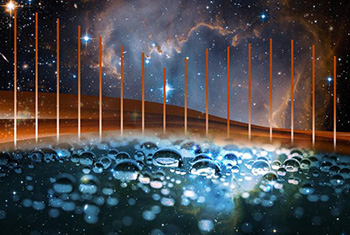
Chemists at CalTech have demonstrated a THz frequency comb that acts as a precise ruler to detect organic molecules and water in space. Credit: Lance Hayashida/CalTech and NASA/ESA/ and the Hubble Heritage Team (STScI/AURA) - ESA/Hubble Collaboration
Optical frequency combs have been investigated for nearly two decades as precise measurement tools in chemistry, physics, medicine and astronomy. Recent research in terahertz (THz) frequency combs have made progress in identifying the chemical fingerprints of molecules, but untangling the multitude of potential molecular signatures in complex arrangements such as those in faraway stellar nurseries and planet-forming accretion disks has been challenging. In a breakthrough in precision, scientists at the California Institute of Technology (CalTech, USA) have demonstrated a technique to simultaneously measure absorption at an unprecedented resolution (tooth spacing) at numerous frequencies across a wide region of the THz spectrum (Phys. Rev. Lett., doi: 10.1103/PhysRevLett.114.163902).
Geoffrey Blake and his team created the scheme using an asynchronous optical sampling (ASOPS) THz spectrometer with two 80 MHz Ti:sapphire femtosecond laser oscillators from Coherent (Santa Clara, Calif., USA). The oscillators enable measurement of transitions between 1 to 2 THz, which can be extended to 20 THz with optical pulse compression and emitter optimization. The technique generated and detected a THz comb extending from 0.15 to 2.4 THz with a tooth spacing of 80 MHz and a linewidth of 3.7 kHz, which is a 14-fold improvement in fractional accuracy and a 675-fold reduction in tooth width. The advance is the first demonstration of broadband, Doppler-limited spectroscopy in the THz region.
Lead author and CalTech graduate student Ian Finneran says that the approach enables separation and processing of more than 10,000 frequencies all at once. “In the near future, we hope to bump that number up to more than 100,000,” said Finneran.
The team hopes the technique could be used to identify all of the intermolecular vibrations of hydrogen-bonded clusters in a single experiment, making it applicable in observing water in interstellar clouds as well as new fields of precision metrology.
